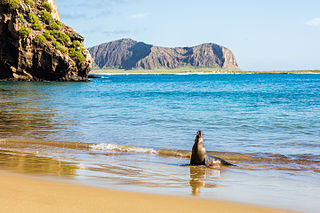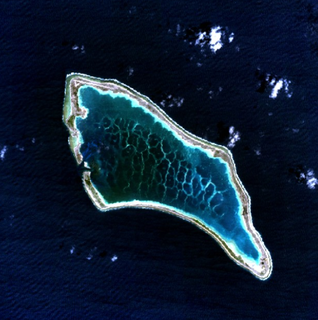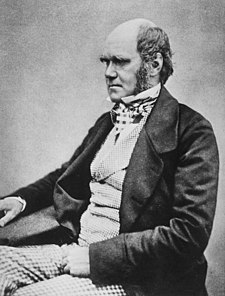
Saint Helena is an island in the South Atlantic Ocean, about midway between South America and Africa. St Helena has a land area of 122 square kilometres and is part of the territory of Saint Helena, Ascension and Tristan da Cunha which includes Ascension Island and the island group of Tristan da Cunha.

Rhyolite is the most silica-rich of volcanic rocks. It is generally glassy or fine-grained (aphanitic) in texture, but may be porphyritic, containing larger mineral crystals (phenocrysts) in an otherwise fine-grained rock. The mineral assemblage is predominantly quartz, sanidine and plagioclase. It is the extrusive equivalent to granite.

The Galápagos Islands, part of the Republic of Ecuador, are an archipelago of volcanic islands distributed on either side of the equator in the Pacific Ocean surrounding the centre of the Western Hemisphere. Located 906 km (563 mi) west of continental Ecuador, the islands are known for their large number of endemic species that were studied by Charles Darwin during the second voyage of HMS Beagle. His observations and collections contributed to the inception of Darwin's theory of evolution by means of natural selection.

Trachyte is an extrusive igneous rock composed mostly of alkali feldspar. It is usually light-colored and fine-grained, with minor amounts of mafic minerals, and is formed by the rapid cooling of lava enriched with silica and alkali metals. It is the volcanic equivalent of syenite.

Phonolite is an uncommon extrusive rock, of intermediate chemical composition between felsic and mafic, with texture ranging from aphanitic (fine-grained) to porphyritic. Its intrusive equivalent is nepheline syenite.

Volcanic rock is a rock formed from lava erupted from a volcano. In other words, it differs from other igneous rock by being of volcanic origin. Like all rock types, the concept of volcanic rock is artificial, and in nature volcanic rocks grade into hypabyssal and metamorphic rocks and constitute an important element of some sediments and sedimentary rocks. For these reasons, in geology, volcanics and shallow hypabyssal rocks are not always treated as distinct. In the context of Precambrian shield geology, the term "volcanic" is often applied to what are strictly metavolcanic rocks. Volcanic rocks and sediment that form from magma erupted into the air are called "volcaniclastics," and these are technically sedimentary rocks.

A shield volcano is a type of volcano named for its low profile, resembling a warrior's shield lying on the ground. It is formed by the eruption of highly fluid lava, which travels farther and forms thinner flows than the more viscous lava erupted from a stratovolcano. Repeated eruptions result in the steady accumulation of broad sheets of lava, building up the shield volcano's distinctive form.

Darwin's finches are a group of about 18 species of passerine birds. They are well known for their remarkable diversity in beak form and function. They are often classified as the subfamily Geospizinae or tribe Geospizini. They belong to the tanager family and are not closely related to the true finches. The closest known relative of the Galápagos finches is the South American Tiaris obscurus. They were first collected by Charles Darwin on the Galápagos Islands during the second voyage of the Beagle. Apart from the Cocos finch, which is from Cocos Island, the others are found only on the Galápagos Islands.

Catherine Joséphine "Katia" Krafft and her husband, Maurice Paul Krafft, were French volcanologists who died in a pyroclastic flow on Mount Unzen, in Japan, on June 3, 1991. The Kraffts were known for being pioneers in filming, photographing and recording volcanoes, often getting within feet of lava flows. Their obituary appeared in the Bulletin of Volcanology. Werner Herzog's documentary Into the Inferno highlights them.

Christian Leopold von Buch, usually cited as Leopold von Buch, was a German geologist and paleontologist born in Stolpe an der Oder and is remembered as one of the most important contributors to geology in the first half of the nineteenth century. His scientific interest was devoted to a broad spectrum of geological topics: volcanism, petrology, fossils, stratigraphy and mountain formation. His most remembered accomplishment is the scientific definition of the Jurassic system.

Tachylite is a form of basaltic volcanic glass. This glass is formed naturally by the rapid cooling of molten basalt. It is a type of mafic igneous rock that is decomposable by acids and readily fusible. The color is a black or dark-brown, and it has a greasy-looking, resinous luster. It is very brittle and occurs in dikes, veins and intrusive masses. The word originates from the Ancient Greek: ταχύς, meaning swift.

Isabela Island is the largest island of the Galápagos with an area of 4,586 square kilometres (1,771 sq mi) and length of 100 kilometres (62 mi), almost four times larger than Santa Cruz, the second largest of the archipelago. Isabela Island is larger than every other island in the Galápagos combined. It was named after Queen Isabella I of Castile. The island straddles the equator. This island was originally named Albemarle Island for the Duke of Albemarle by Ambrose Cowley, one of the first Europeans to set foot on the islands, in 1684.

Santiago Island is one of the Galápagos Islands. It is also known as San Salvador, named after the first island discovered by Columbus in the Caribbean Sea, or as James Island. The island, which consists of two overlapping volcanoes, has an area of 585 square kilometers (226 sq mi) and a maximum altitude of 907 meters (2,976 ft), atop the northwestern shield volcano. The volcano in the island's southeast erupted along a linear fissure, and is much lower. The oldest lava flows on the island date back to 750,000 years ago.

Floreana Island is an island of the Galápagos Islands. It was named after Juan José Flores, the first president of Ecuador, during whose administration the government of Ecuador took possession of the archipelago. It was previously called Charles Island, and Santa María after one of the caravels of Columbus.

Wolf Island or Wenman Island is a small island in the Galápagos Islands and was named after the German geologist Theodor Wolf, who also has the volcano Wolf on Isabela Island named after him. It has an area of 1.3 square kilometres and a maximum altitude of 253 metres above sea level.

The second voyage of HMS Beagle, from 27 December 1831 to 2 October 1836, was the second survey expedition of HMS Beagle, under captain Robert FitzRoy who had taken over command of the ship on its first voyage after the previous captain, Pringle Stokes, committed suicide. FitzRoy had thought of the advantages of having someone onboard who could investigate geology, and sought a naturalist to accompany them as a supernumerary. At the age of 22, the graduate Charles Darwin hoped to see the tropics before becoming a parson and accepted the opportunity. He was greatly influenced by reading Charles Lyell's Principles of Geology during the voyage. By the end of the expedition, Darwin had made his name as a geologist and fossil collector and the publication of his journal gave him wide renown as a writer.

Comendite is a hard, peralkaline igneous rock, a type of light blue grey rhyolite. Phenocrysts are sodic sanidine with minor albite and bipyramidal quartz. Comendite occurs in the mountains Tibrogargan, Coonowrin, Tunbubudla, Coochin, Saddleback, Tibberoowuccum and Ngungun in the Glass House Mountains, South East Queensland, Australia. The blue colour is caused by very small crystals of riebeckite or arfvedsonite. Comendite also occurs in Sardinia, Corsica, Ascension Island, Ethiopia, Somalia and other areas of East Africa. The 1903 eruption of Changbaishan volcano in north-east China erupted comendite pumice.

The Structure and Distribution of Coral Reefs, Being the first part of the geology of the voyage of the Beagle, under the command of Capt. Fitzroy, R.N. during the years 1832 to 1836, was published in 1842 as Charles Darwin's first monograph, and set out his theory of the formation of coral reefs and atolls. He conceived of the idea during the voyage of the Beagle while still in South America, before he had seen a coral island, and wrote it out as HMS Beagle crossed the Pacific Ocean, completing his draft by November 1835. At the time there was great scientific interest in the way that coral reefs formed, and Captain Robert FitzRoy's orders from the Admiralty included the investigation of an atoll as an important scientific aim of the voyage. FitzRoy chose to survey the Keeling Islands in the Indian Ocean. The results supported Darwin's theory that the various types of coral reefs and atolls could be explained by uplift and subsidence of vast areas of the Earth's crust under the oceans.

Igneous rock, or magmatic rock, is one of the three main rock types, the others being sedimentary and metamorphic. Igneous rock is formed through the cooling and solidification of magma or lava.

Geological Observations on South America is a book written by the English naturalist Charles Darwin. The book was published in 1846, and is based on his travels during the second voyage of HMS Beagle, commanded by captain Robert FitzRoy. HMS Beagle arrived in South America to map out the coastlines and islands of the region for the British Navy. On the journey, Darwin collected fossils and plants, and recorded the continent's geological features.

















